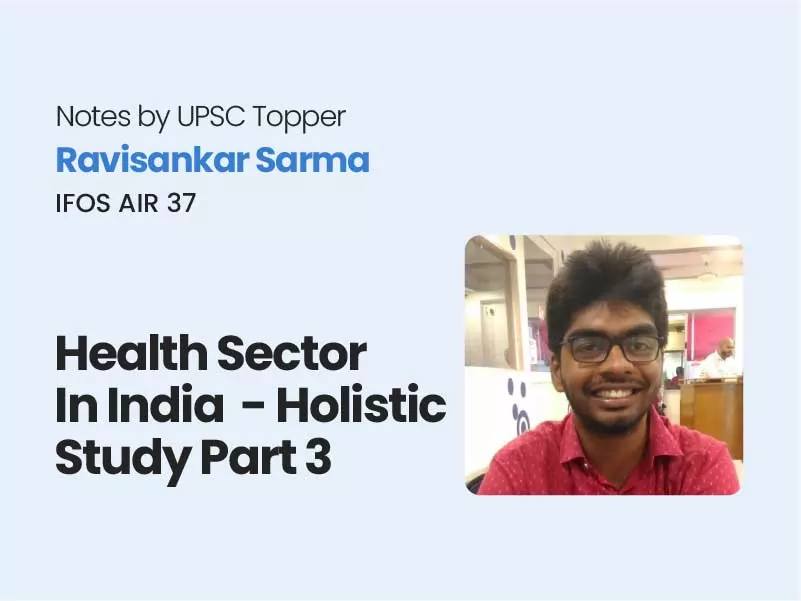Companion@360 → 7 Month programme to sharpen your writing skills → REGISTER NOW

Health Sector In India– Part 1 Part 2
National Rural Health Mission (NRHM)
Introduction
The NRHM aims to provide a fully functional, community-owned, decentralized healthcare delivery system with inter-sectoral convergence at all levels to ensure action on multiple indicators – water, sanitation, education, nutrition, social and gender equality
Features
- Main target to provide access to affordable quality healthcare services to rural population
- Section Focus: Special focus on vulnerable sections: Women and Children: RMNCH+A – Reproductive, Maternal, New born, Child and Adolescent
- Region Focused: Targeted focus on improving primary healthcare services in Empowered Action Group States and North-East
- Community Participation: Improved Community level participation through Mahila Arogya Samiti, Rogi Kalyan Samiti and Village Health and Nutrition Council
ASHA – Accredited Social Health Activists
- Community Health volunteers called Accredited Social Health Activists (ASHAs) have been engaged under the mission for establishing a link between the community and the health system
- ASHA is the first port of call for any health-related demands of deprived sections of the population, especially women and children, who find it difficult to access health services in rural areas.
Rogi Kalyan Samiti (Patient Welfare Committee)
- Group of trustees of the hospital to Manage affairs of hospitals
Janani Suraksha Yojana (JSY)
- JSY aims to reduce maternal mortality among pregnant women by encouraging institutional delivery.
- Under the scheme, cash assistance is provided to eligible pregnant women for giving birth in a government health facility.
National Mobile Medical Units (NMMUs)
- Many un-served areas have been covered through National Mobile Medical Units (NMMUs).
National Ambulance Services
- Free ambulance services are provided in every nook and corner of the country connected with a toll-free number and reach within 30 minutes of the call.
Janani Shishu Suraksha Karyakram (JSSK)
- As part of recent initiatives and further moving in the direction of universal healthcare, Janani Shishu Suraksha Karyakarm (JSSK) was introduced to provide free to and fro transport, free drugs, free diagnosis, free blood, and free diet to pregnant women who come for delivery in public health institutions and sick infants up to one year.
Rashtriya Bal Swasthya Karyakram (RBSK) – In line with Article 45 of DPSP (Early Childhood Care)
- A Child Health Screening and Early Intervention Services have been launched in February 2013 to screen diseases specific to childhood, developmental delays, disabilities, birth defects and deficiencies. The initiative will cover about 27 crore children between 0–18 years of age and also provide free treatment including surgery for health problems diagnosed under this initiative.
Mother and Child Health Wings (MCH Wings)
- With a focus to reduce maternal and child mortality, dedicated Mother and Child Health Wings with 100/50/30 bed capacity have been sanctioned in high case load district hospitals and CHCs which would create additional beds for mothers and children.
Free Drugs and Free Diagnostic Service
- A new initiative is launched under the National Health Mission to provide Free Drugs Service and Free Diagnostic Service with a motive to lower the out of pocket expenditure on health.
District Hospital and Knowledge Centre (DHKC)
- As a new initiative District Hospitals are being strengthened to provide Multi-specialty health care including dialysis care, intensive cardiac care, cancer treatment, mental illness, emergency medical and trauma care These hospitals would act as the knowledge support for clinical care in facilities below it through a telemedicine centre located in the district headquarters and also developed as centres for training of paramedics and nurses.
National Iron+ Initiative
- The National Iron+ Initiative is an attempt to look at Iron Deficiency Anaemia in which beneficiaries will receive iron and folic acid supplementation irrespective of their Iron/Hb status. This initiative will bring together existing programmes (IFA supplementation for: pregnant and lactating women and; children in the age group of 6–60 months) and introduce new-age groups.
FROM NRHM to NHM
Why NHM?
- Integrated Focus on rural and urban areas earlier missing in NRHM
- Holistic Focus: Focus expanded from mother and children centric health issues to diverse sections of society
- Long Term Vision: NRHM lacked long term vision as it was launched in mission mode
- Regional Equity: Highly variable delivery of services across states
NUHM
Envisages to meet healthcare needs of urban population with special focus on urban poor and other vulnerable sections seeking to improve their outreach to primary healthcare services and reducing their out of pocket expenditure in availing healthcare services.
Focus on meeting healthcare needs of slum population with convergence with schemes of other ministries engaged in enhancing related health determinants- water, sanitation, education, housing etc – Ministry of Urban Development, Housing and Urban Poverty Alleviation, MHRD and MWCD
Pathway to achieving NUHM goals
- Need-based healthcare delivery system to meet diverse healthcare needs of urban poor and other vulnerable sections like street vendors, rickshaw pullers, coolies, construction workers
- Availability of resources for providing primary healthcare to urban poor
- Institutional mechanism and management system to deal with rapidly growing urban population (multi-sector convergence – water, housing, sanitation)
- Partnership with the community and local bodies for proactive involvement in planning, implementation and monitoring of health activities
- Partnerships with NGOs, health service providers and other stakeholders
